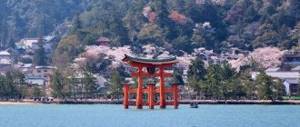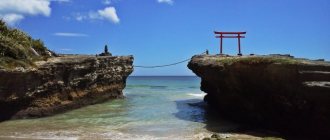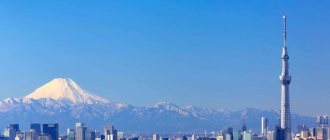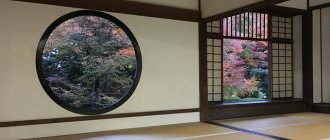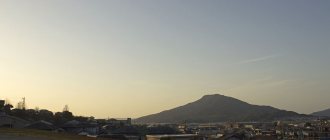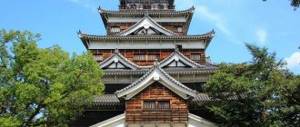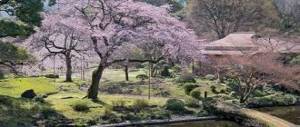On the banks of Japan's Ota River in the heart of Hiroshima lies the great Peace Memorial. This is an old, badly damaged building with a large dome that has a round shape. This is all that remains after the nuclear explosion in Hiroshima. The Japanese come here to lay wreaths and remember those terrible events that made the whole world shudder.
This building once housed a huge number of organizations and hosted a variety of cultural and artistic exhibitions and events. It is known that a large number of people were present in the building on the day the bomb was dropped. It’s scary to imagine all this horror and the scale of the tragedy.
How did the Peace Memorial come about?
Due to the nuclear bombing, Hiroshima was almost leveled to the ground. The Japanese had to rebuild the city from the ashes, piece by piece. But the dilapidated building overlooking the city was so impressive that they decided to turn it into a Memorial. A monument that would serve as a reminder and edification for future descendants. A symbol of the grief and suffering that the Japanese people had to endure.
But the restoration and construction of the memorial did not begin immediately. It took too long to rebuild the entire city. The building was surrounded by a small fence and forgotten for a while. Gradually, the area around the building became very overgrown, more and more cracks appeared in the walls, and the structure threatened to suddenly collapse.
It was only in 1967 that the first restoration of the building was carried out. After this, the memorial was updated and strengthened more than once.
Currently, the Hiroshima monument has been completely restored. The memorial dome appears to tourists in its original form.
Peace Memorial in Hiroshima. Memory of a distant explosion
Post-war Japan is famous for its largest public ensemble, which was designed and built by one of the most famous architects of the twentieth century, Kenzo Tange, the Peace Memorial in Hiroshima (Japan). This complex is an organic fusion of national ideas and modern plastic art in space.
Peace Park (or Hiroshima Peace Memorial) is one of the major must-see attractions in Hiroshima. Its study is even included in the curriculum of Japanese schoolchildren. In this article we will introduce the reader in more detail to the monuments of this memorial complex.
Hiroshima Memorial Park
Not far from the memorial monument, the Peace Memorial Park was laid out. Its huge area amazes and impresses tourists. It was founded in the very center of a nuclear explosion. This location used to be the major political and commercial center of Hiroshima.
Currently, a large Memorial Museum is open in the park, filled with exhibits that can say a lot about the tragedy that happened. There is also a huge ritual bell, preserved after the explosion. Several memorial monuments were erected near the museum. And in the center of the park a large tombstone was created in memory of all those who died in this terrible tragedy.
The museum building is divided into two parts. All exhibits are located in the western wing of the museum. Having visited another part of the museum, tourists will be able to hear numerous stories from guides about World War II, and what role Japan played in it.
Every year, in the month of August, a funeral ceremony is held in this park. The entire city can hear the deafening ringing of the ritual bell. And in the evening everyone goes to the river and throws colorful glowing lanterns across the water. They are a kind of symbol of peace and goodness. On this day, people remember the dead and lay flowers and wreaths on the gravestone. Some bring soft toys. People hope that this terrible tragedy will never happen again.
Other monuments
In the park and its surroundings there are a total of more than 50 different monuments erected by schools and industrial groups. Let's talk about some of them.
6 - Atomic tree
The firmiana tree, growing north of the east wing of the Peace Memorial Museum, was transplanted to the Peace Park in 1973, and originally grew 1.3 km from the epicenter of the explosion. Due to radiation and the shock wave, it seemed to wither, but the following spring it budded again, instilling hope in the hearts of survivors of the bombing.
7 - Monument to students of Hiroshima Girls' High School
At this school, 676 students and school employees died, this is the largest number among educational institutions in Hiroshima. The formula “E=MC²” is engraved on the monument. The monument was erected by the school in 1948, and in 1957 it was moved to its current location. It is also notable for the fact that it does not contain the words “atomic bombing” - at the time of the creation of the monument, Japan was occupied by Allied troops, and these words could not be used.
8 – Monument to Koreans killed by the atomic bomb
Installed in 1970, and in 1999 moved to the Peace Memorial Park. Before the war, Hiroshima was a military-industrial city, where there were many military enterprises, where those who were mobilized were brought to serve their labor service. At that time, about 100 thousand natives of the Korean Peninsula lived in Hiroshima, and about 20 thousand of them died in the atomic bombing. On the southern side of this monument there is a stone tombstone that survived the atomic explosion.
Remembrance and enlightenment for peace
Museum workers pay great attention to holding thematic lectures, meetings with event participants, conferences, and round tables that take place within the walls of the museum. After all, it is important not only to preserve the memory of Hiroshima, but also to skillfully convey it to the younger generation, to all of humanity. Realizing that every year there are fewer and fewer eyewitnesses to the bombing of Hiroshima and it is becoming increasingly difficult for them to speak out, museum workers recorded video lectures and a video message from these people. Therefore, anyone, anywhere in the world, can view them at any time.
Peace Museum inside
On the territory of the museum there are 2 conference rooms (for 50 and 150 seats), a seminar hall (for 100 seats), as well as a spacious Peace Memorial Hall, designed for 320 seats. Numerous meetings and conferences take place here almost every day. Interestingly, there is an opportunity to invite a living participant in the events of the bombing of Hiroshima to the meeting. However, this service is paid and not cheap. In addition, an application for such a meeting must be booked at least a month before arrival.
Each tourist can take an audio guide and listen to a lecture while exploring the museum on their own. You can select English or Japanese to listen to. The recording duration is 60 minutes. The story includes the history of the tragedy in Hiroshima, the memories of eyewitnesses, the opinions of scientists about the consequences of the bombing on the health of different generations in Japan, and also reflects the desire for world peace.
Exhibit
Much attention is paid here to volunteer movements. Young people volunteer to conduct excursions in the museum and the adjacent Peace Park. A big advantage of the museum’s service is the ability to book an excursion in advance, even a year before the time of your visit to Hiroshima.
Shukkei-en Garden
It is a tranquil garden surrounded by greenery and located in the city center of Hiroshima. It was originally built in 1620 as part of the residence of the daimyo Asano.
At the beginning of spring, plums bloom, and later cherries, in summer - water lilies, and all four seasons of the year this garden welcomes visitors with flowers. Formal tea ceremonies are often held on weekends, including outdoor parties (for a fee). On the left side of the gate is Sensui-tei, where you can get a matcha tea set (sweets for 500 yen).
If you find yourself at Hiroshima Station, be sure to visit this garden; it’s just a short walk away.
Memory of the past for the sake of the future
The Hiroshima Peace Memorial Museum is a kind of calling card of the city. This establishment has no analogues in the world. Therefore, visiting it is the duty of every guest of the city. The museum has several interesting locations. However, the old wristwatch in the center of the exhibition hall attracts special attention. The shooters stopped at them at the time when the bombing of the city began.
Wristwatches at the Hiroshima Peace Museum
By the way, the Hiroshima Peace Museum is one of the military museums. Today the museum occupies a spacious building with an area of 1023 m2. It was created back in 1955. Today, the museum, having undergone a total reconstruction in 1991, expanded its area and funds, and in 1994 the renovated Peace Memorial Hall was opened here. The main purpose of the museum is to preserve bombing artifacts and personal belongings that belonged to the city's residents.
In the museum
The museum itself has a fairly simple layout structure and consists of the main building and the eastern section, where the main exhibitions of the museum take place. Opened in April 2021, the East Building consists of three parts: Introductory Exhibition, The Dangers of Nuclear Weapons, and The History of Hiroshima.
In the East Building, visitors can access video testimonies of bombing victims and special exhibits temporarily installed on the 1st floor.
Exhibition in the museum
In the next two years, it is planned to arrange special exhibitions on the ground floor that will show the reality of the tragic events of August 6, 1945 in the lives of the residents of Hiroshima.
Itsukushima (Miyajima Island)
Itsukushima or Miyajima Island, is one of the main attractions of Hiroshima, it is located in the northwestern part of Hiroshima Bay. Miyajima is famous for the large number of temples and shrines on the island, as well as for its main attraction, namely the giant Torii Gate, which floods during high tide and appears to float on water. In addition to the Torii Gate, Itsukushima Castle is a UNESCO World Heritage Site, with records indicating that the temple was founded during the time of Empress Suiko in the 15th century. In addition to all this, Itsukushima Island and the waters surrounding it are included in the Seto-Nikai National Park.
The Story of Sadako Sasaki
Over time, the story of this real child became overgrown with all sorts of speculation and embellishments. But, nevertheless, the fact is the following. On August 6, 1945, like many other children in Hiroshima, Sadako, who was only two years old at that time, was playing with toys at home. When a uranium bomb exploded one and a half kilometers from the house, the child was thrown out of the window by the blast wave.
Miraculously, Sadako was able to survive. But soon she was diagnosed with leukemia. Huge tumors appeared on the neck and behind the ears. Doctors did not guarantee her even six months of life. But the little girl fought for another ten years.
One day, one of her friends, perhaps a fellow child who suffered from an explosion and was being treated for leukemia, told Sadako a legend. It said that whoever folds a thousand origami cranes out of paper will receive the fulfillment of his most cherished desire. The girl wanted to live more than anything in the world, because she was still so young. She began to fold origami paper figures from every piece of paper that fell into her hands.
It is believed that she had very little left to fold. But she died. Then her friends made a lot of paper cranes and brought them to her grave. The girl was buried with all the figures she had made. Since then, the tradition of folding paper cranes with wishes for a peaceful life has been firmly established in Japan for 70 years. Children and adults fold up the figures and leave them at the monument to the brave girl who loved life most of all.
The youngest "hibakusha"
At the intersection directly opposite the Dome, there is a man named Kosei Mito. He has been coming here almost every day for more than ten years to tell tourists his story. When the atomic bomb was dropped on Hiroshima, Mito was not yet born - he was in the womb of his mother, who was four months pregnant. He is one of the youngest hibakusha. This is what people in Japan call those who survived the atomic bombings. The house in which Mito's parents lived was located only one kilometer from the epicenter of the explosion, but by luck that day, August 6, his mother Tomie spent the night at her parents' house seven kilometers from Hiroshima.
